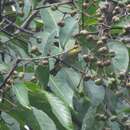zh-TW
在導航的名稱


Swinhoe's white-eye (Zosterops simplex) is a bird species in the white-eye family Zosteropidae. It is found in east China, Taiwan, north Vietnam, the Thai-Malay Peninsula, Sumatra and Borneo. Populations have also been introduced throughout Southern California.
Swinhoe's white-eye was formally described in 1861 by the English naturalist Robert Swinhoe and given the binomial name Zosterops simplex.[1] The genus Zosterops had been introduced by the naturalists Nicholas Vigors and Thomas Horsfield in 1827.[2] The genus name combines the Ancient Greek words zōstēros meaning "belt" or "girdle" and ōpos meaning "eye". The specific epithet simplex is Latin meaning "simple" or "plain".[3]
This species was formerly treated as a subspecies group of the warbling white-eye (Zosterops japonicus) but based on the results of a molecular phylogenetic study published in 2018, it was promoted to species rank.[4][5]
Five subspecies are recognised:[5]
Swinhoe's white-eye (Zosterops simplex) is a bird species in the white-eye family Zosteropidae. It is found in east China, Taiwan, north Vietnam, the Thai-Malay Peninsula, Sumatra and Borneo. Populations have also been introduced throughout Southern California.
El anteojitos de Swinhoe (Zosterops simplex) es una especie de ave paseriforme de la familia Zosteropidae propia de Asia Oriental. Anteriormente era tratada como subespecie del anteojito japonés, pero en base al resultado de un estudio de filogenética molecular publicado en 2018,[1] en la actualidad se considera como especie separada.[2]
Se reconocen las siguientes subespecies:[2]
El anteojitos de Swinhoe (Zosterops simplex) es una especie de ave paseriforme de la familia Zosteropidae propia de Asia Oriental. Anteriormente era tratada como subespecie del anteojito japonés, pero en base al resultado de un estudio de filogenética molecular publicado en 2018, en la actualidad se considera como especie separada.